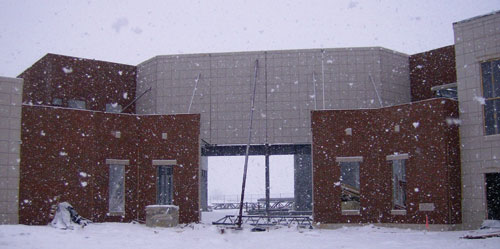First in Their Class: Innovative Design Solutions for Schools of the Future
Thermal Mass Serving Multiple Functions
Along with energy efficiency, speed of construction, durability and prefabrication, materials that are high in recycled content, are important attributes for school buildings. Designers can use one material system to solve multiple aspects of the building design. Precast concrete sandwich wall panel systems are being left exposed to serve as the interior wall finish, as well as exterior envelopes. Precast walls are both structural and aesthetic, and can be finished with a variety of colors, textures, or veneer materials.
 |
Precast concrete can be quickly erected even in the winter, as shown in construction photo of Willow Creek Elementary School in Fleetwood, Pennsylvania. Photo courtesy of High Concrete Group LLC; Designed by AEM Architects Inc. |
Concrete walls can also have integral colorants (pigments) applied to the mix, creating a consistent wall surface color even through renovations. Concrete is hard to scratch or nick and products are available to seal these durable wall surfaces. Manufactured off-site, these wall panels can contain continuous insulation and can be designed to meet performance values for acoustic design. When used as an interior wall with lighter-colored finishes, its reflectance can lower interior lighting costs. Concrete has low to negligible VOCs, improving indoor air quality, and it can contain recycled content and is recyclable.
Precast building walls and floors allow a design professional to take advantage of thermal mass as a design strategy. Due to its density, concrete has the capacity to absorb and store large quantities of heat, and then release it back into the building as the interior temperature decreases, contributing to a high-performance building envelope. The thermal mass effect reduces peak heating and cooling loads and delays the time at which these loads occur. The resulting savings can be significant-up to 30 percent of heating and cooling costs. Designers must understand the overall envelope system in order to optimize the benefits of using thermal mass. ASHRAE Standard 90.1 allows design professionals to lower minimum insulation R-values and provides higher maximum wall U-factors as a result of the properties of these wall assemblies.
Precast concrete is a durable, long-lasting material that is noncombustible, providing natural fire control, and resistant to wind, hurricanes and floods. It is nonorganic and cannot support mold growth. Precast concrete can be quickly erected, allowing the building to be enclosed faster. Manufactured in controlled factories, finish quality and high insulation properties can be guaranteed. Precast concrete reduces life cycle costs and with strengths of 6,000 to 7,000 pounds per square inch, it's an extremely durable building material.









